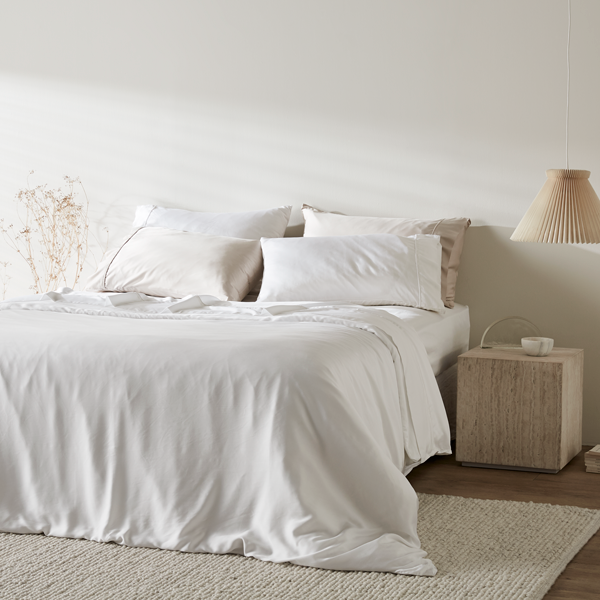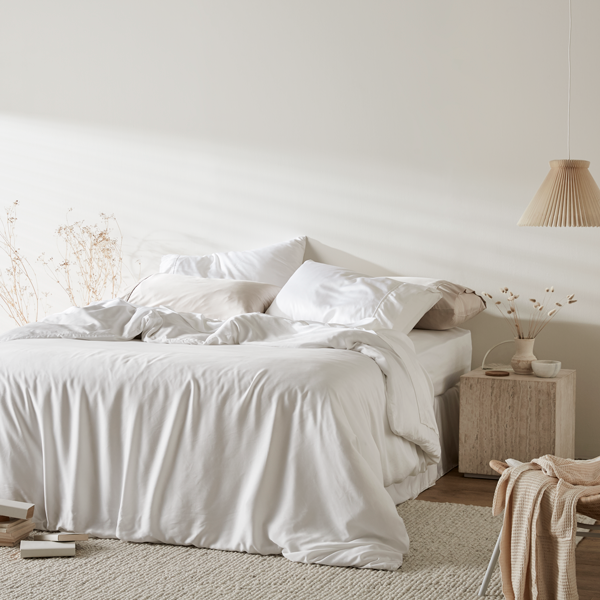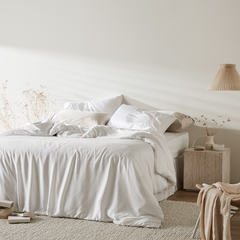Which is the most sustainable fiber? Bamboo Viscose vs Tree-based Lyocell vs Bamboo Lyocell
Over the past two decades, global fibre production has nearly doubled, increasing from 58 million tonnes in 2000 to 116 million tonnes in 2022. Projections suggest this figure could reach 147 million tonnes by 2030. Per capita fibre production has also surged, growing from 8.3 kg in 1975 to 14.6 kg in 2022. This sharp rise in fibre production presents significant environmental challenges, underscoring the urgent need to shift towards sustainable fibres and reduce our dependence on virgin, fossil-based synthetics. Achieving the target of a 45% reduction in greenhouse gas (GHG) emissions by 2030 is critical to aligning with the global effort to limit temperature increases to 1.5°C, as outlined in the Paris Agreement.
The Environmental Impact of Synthetic Fibres
Synthetic fibres like polyester and spandex, which accounted for 62% of the textile market in 2020, have a detrimental impact on the environment. These materials are largely non-biodegradable, persisting in the environment for centuries and leaching harmful chemicals into soil and groundwater. Additionally, microfibres from these polymers are released during clothing production, daily wear, and washing, contaminating water sources and even entering human bodies through inhalation, posing a significant health risk.
Man-Made Cellulosic Fibres: A Sustainable Alternative
Man-Made Cellulosic Fibres (MMCFs), primarily derived from wood, offer a sustainable alternative to synthetic fibres due to their natural, renewable, and biodegradable properties. Their importance is growing, with production having doubled over the last thirty years and expected to continue rising. MMCFs provide environmental benefits by reducing reliance on petroleum-based synthetics and using less water than cotton farming.
Among MMCFs, viscose dominates the market with an 80% share, while wood-based lyocell holds a 4% share, ranking third in usage as of 2022. CleanBamboo® bamboo lyocell is also gaining popularity. Choosing the most sustainable option involves assessing their production processes, resource efficiency, and environmental impact, which is vital for eco-conscious businesses and consumers alike.
Evaluating Sustainability
1. Water Footprint
The water footprint measures human appropriation of freshwater in volumes consumed and/or polluted. It includes three types:
- Green water footprint: Water from precipitation stored in the soil's root zone and evaporated, transpired, or absorbed by plants.
- Blue water footprint: Water sourced from surface or groundwater, either evaporated, incorporated into a product, or transferred between water bodies.
- Grey water footprint: Freshwater required to assimilate pollutants to meet water quality standards.
Producing one tonne of viscose staple fibre consumes 65 tonnes of freshwater, with the most significant water usage occurring during the dissolving wood pulp and fibre production stages, which have high blue and grey water footprints. Viscose production requires substantial amounts of freshwater to assimilate pollutants due to the heavy use of harmful chemicals.
In contrast, the lyocell process has a much lower water footprint, as it uses organic solvents and closed-loop systems that nearly fully recover the chemicals used (98% recovery). Between tree-based lyocell (Tencel) and CleanBamboo® lyocell, CleanBamboo® has an even lower water footprint, as bamboo requires much less water to grow than trees.
2. Deforestation
Viscose and tree-based lyocell are mainly derived from wood pulp, with over 200 million trees logged annually to produce these cellulosic fabrics. Some of these trees are sourced from ancient and endangered forests, and others from plantations that have replaced natural forests.
Plantations on peatland can have a significant climate impact, releasing carbon from the peat into the atmosphere. Studies have found that pulpwood plantations on drained peat release an average of 100 tonnes/hectare/year of CO2, equivalent to 98 return flights between London and New York.
Logging forests also impacts Indigenous peoples and local communities by depriving them of access to traditional land uses, affecting everything from food security to community safety and cultural practices.
On the other hand, CleanBamboo® lyocell is derived from bamboo pulp sourced from Ecocert and FSC-certified organic bamboo farms. Bamboo is a grass that can grow rapidly on degraded land without pesticides or fertilisers and sequesters significant amounts of carbon over short periods. Bamboo also provides annual income to some of the poorest communities in tropical and subtropical regions, reducing the pressure to exploit tropical forests unsustainably.
3. Carbon Footprint
A carbon footprint measures the total amount of greenhouse gases that an activity, product, or company adds to the atmosphere, usually reported in tonnes of CO2-equivalent emissions.
According to third-party Life Cycle Assessment (LCA) analysis, CleanBamboo® lyocell emits 36% less CO2 than viscose and 22% less than tree-based lyocell (Tencel).
4. Eutrophication
Eutrophication, the addition of excess nutrients to water bodies, is a widespread environmental problem affecting aquatic habitats. It results in overgrowths of algae and oxygen depletion, creating dead zones where neither plants nor animals can survive. While eutrophication can occur naturally, human activities such as agricultural fertilisers, sewage, industrial waste, and livestock farming have rapidly increased its rates.
Viscose production is chemical-intensive, with wastewater dominated by oxygen-consuming organic substances like zinc sulphate. Other toxic chemicals used in viscose production include sodium hydroxide (caustic soda) and sulphuric acid. If fibres are bleached, effluents may contain harmful chemicals like AOX and chlorates, which have toxic effects on aquatic environments.
In lyocell fibre production, water pollution is reduced due to the use of organic solvents and closed-loop systems that nearly fully recover the chemicals used (98% recovery). Bamboo lyocell has even lower eutrophication levels, as bamboo cultivation requires no fertilisers or pesticides. However, for tree-based lyocell, chemicals used in pest control and fertilisation, soil erosion, and organic matter from debarking and transport degrade water quality; deforestation also alters hydrological patterns, contributing to eutrophication.
5. Fossil Fuels
CleanBamboo® lyocell requires the least amount of fossil fuels to produce. LCA analysis shows that it uses 53% less fossil fuels than viscose and 42% less than Tencel.
Performance
Sustainability alone is not enough for quick market adoption; a product must also perform well. CleanBamboo® lyocell outperforms viscose and Tencel in comfort and durability, according to Intertek testing:
1. Moisture Management
Moisture management refers to the controlled movement of liquid (sweat) from the skin to the environment through fabric. It’s essential for comfort and performance, as it regulates body temperature. Intertek test results show that viscose is 31% less efficient than CleanBamboo® lyocell, and Tencel is 36% less efficient.
2. Cooling Effect
The cooling effect test measures how quickly a fabric cools after being warmed to simulate body heat. CleanBamboo® fabric cools faster than viscose and Tencel, with viscose being 47% slower and Tencel 7% slower in dissipating heat.
3. Durability
A sustainable fabric must be durable, resisting wear through continual use and care. Test results show that CleanBamboo® lyocell is 18% more resistant to pilling and 51% more durable than viscose and Tencel. It also has a 17% better surface appearance after aging, including exposure to UV rays and 20 wash cycles.
Other Factors to Consider
Bamboo is a standout in regenerative agriculture for its low nutrient requirements, rapid growth, and ability to prevent erosion by raising the water table with its robust roots. It produces 35% more oxygen than trees over the same area while absorbing significant amounts of CO2. Bamboo sequesters 17 tonnes of CO2 per hectare annually, with one bamboo stalk sequestering 11.5 times more CO2 than a tree.
Unlike trees, bamboo can be harvested without killing the plant, as its rhizomatous grass structure allows it to continue acting as a carbon sink even after harvesting. Sustainable harvesting of bamboo prevents CO2 and greenhouse gas releases and enhances its role as a carbon sink.
The Verdict
Overall, CleanBamboo® lyocell is a more sustainable next-gen fibre than viscose and tree-based lyocell. It also boasts a fully transparent and traceable supply chain, approved by Canopy Hot Button, all the way to its 100% FSC and Ecocert organic certified bamboo farms.
Browse Bamboo Lyocell Sheets
Ettitude provides a variety of bamboo lyocell sheets designed to meet diverse bedding needs. Known for their softness and breathability, these sheets are a sustainable and comfortable option for those looking to enhance their sleep experience.










